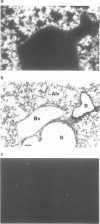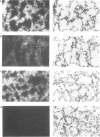Abstract
1. Binding and quantitative autoradiography were used to detect [125I]-iodocyanopindolol (I-CYP) associated with beta 1- and beta 2-adrenoceptors in mouse tracheal epithelium and airway smooth muscle as well as in lung parenchymal tissue. 2. Specific I-CYP binding to slide-mounted tissue sections of both trachea and parenchyma was of high affinity (KD = 49.0 pM, n = 3, trachea; KD = 118.9 pM, n = 3, parenchyma) and saturable, involving single populations of non-interacting binding sites (Hill coefficient nH = 1.00 +/- 0.02, trachea; nH = 0.99 +/- 0.03, parenchyma). 3. Direct measurement of tissue radioactivity also showed that specific I-CYP binding was competitively inhibited in the presence of the beta-adrenoceptor antagonists (-)-propranolol (non-selective), CGP 20712A (beta 1-selective) and ICI 118,551 (beta 2-selective). Analysis of the competition binding curves for the two selective antagonists revealed mixed populations of beta 1- and beta 2-adrenoceptors in the approximate proportions 33% and 67% respectively in mouse trachea and 28% and 72% respectively in mouse lung parenchyma. 4. Densities of autoradiographic grains derived from specific I-CYP binding to alveolar wall tissue and to tracheal epithelium and airway smooth muscle were quantified by a computer-assisted image analysis system, which allowed the construction of competition binding curves in the presence of the selective beta-adrenoceptor antagonists CGP 20712A and ICI 118,551. Analysis of these data demonstrated that in alveolar wall, beta 1- and beta 2-adrenoceptors co-existed in the proportions 18% and 82%, respectively. 5. Quantitative autoradiographic analyses also showed that beta 1- and beta 2-adrenoceptors were differentially distributed in tracheal epithelium and airway smooth muscle. The beta 2-adrenoceptor subtype accounted for 71% of all beta-adrenoceptors in epithelium.(ABSTRACT TRUNCATED AT 250 WORDS)
Full text
PDF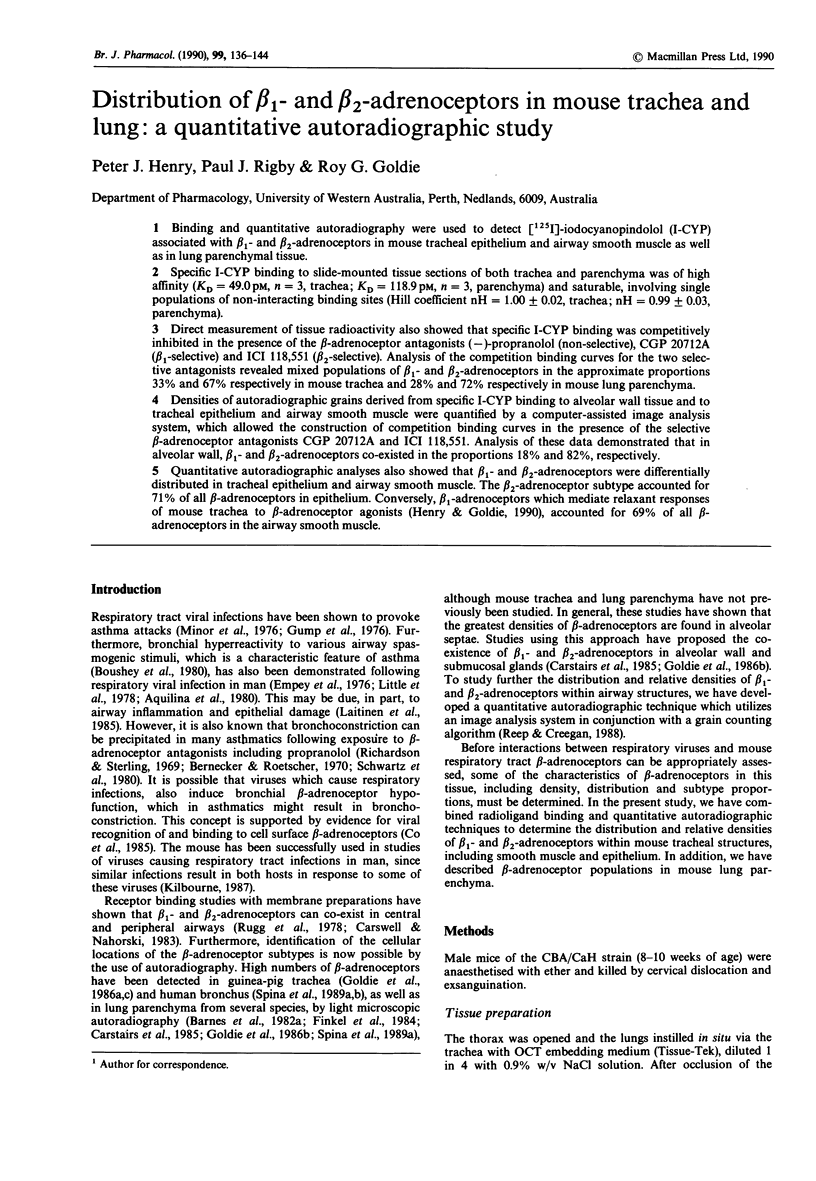
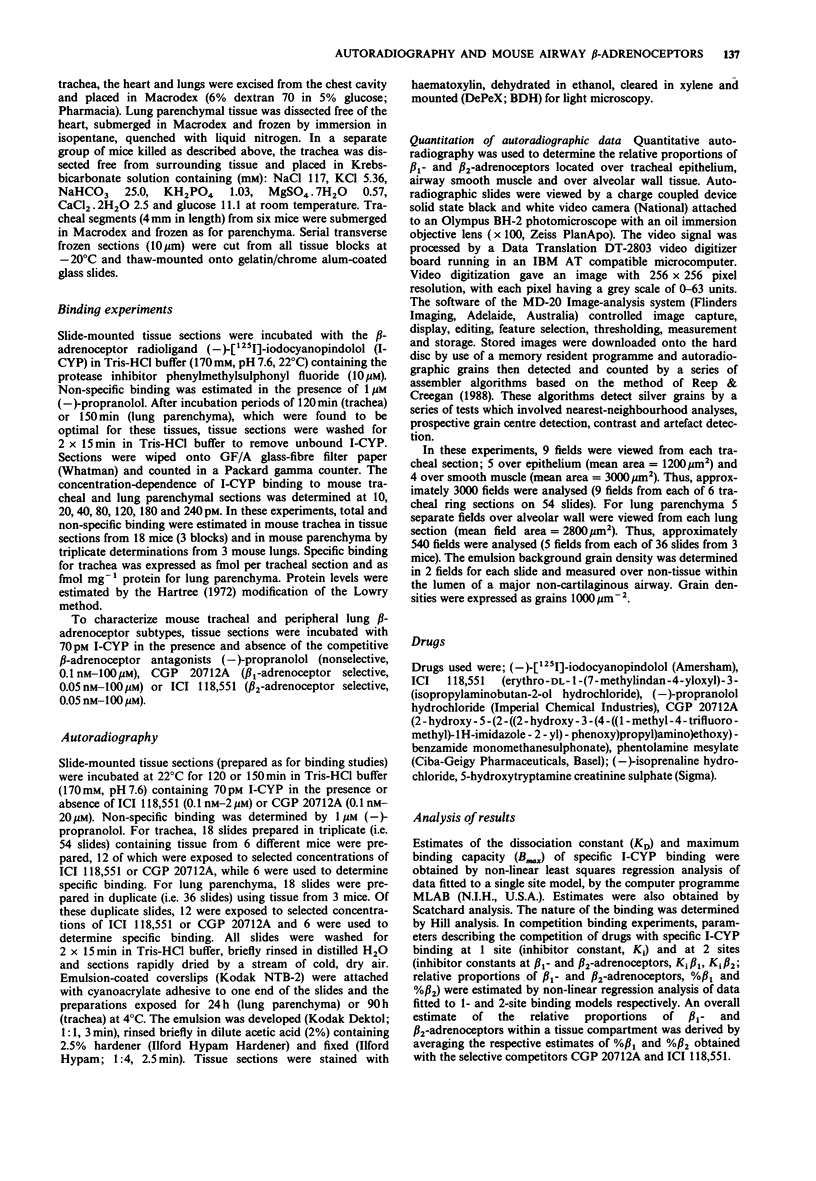
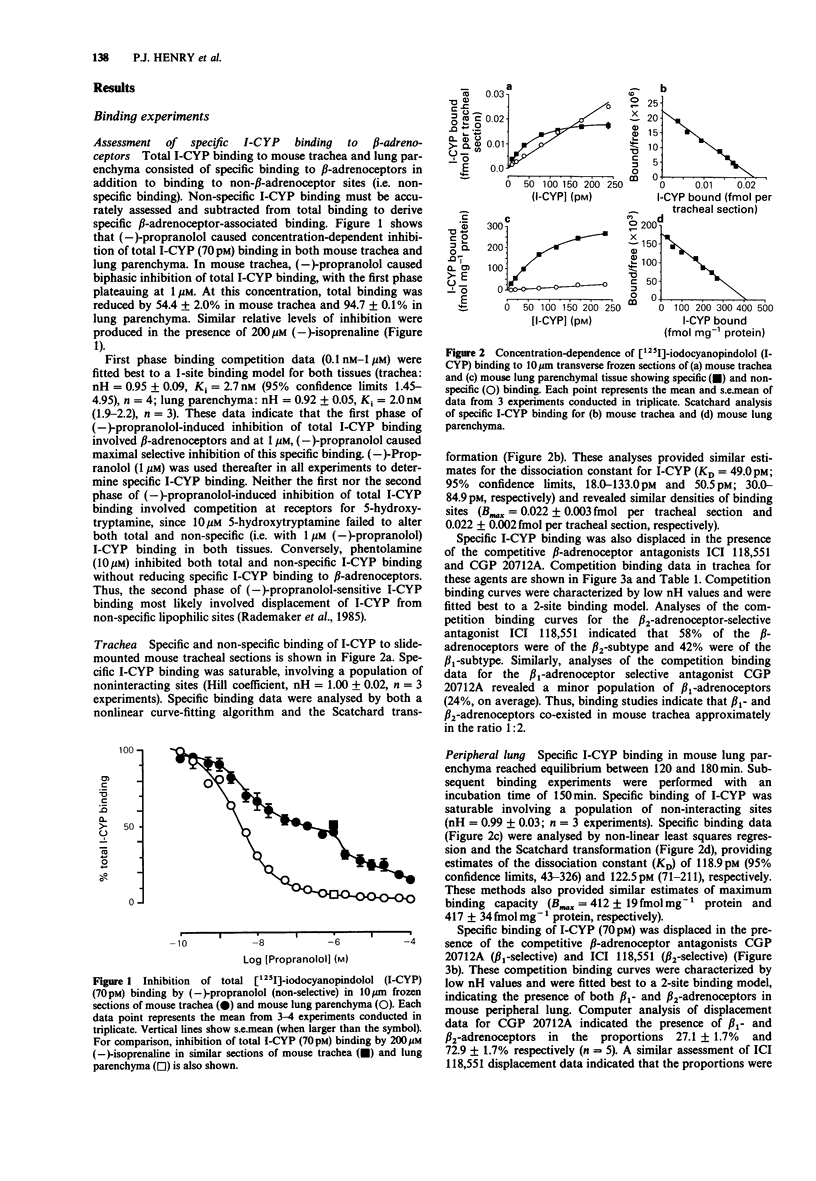
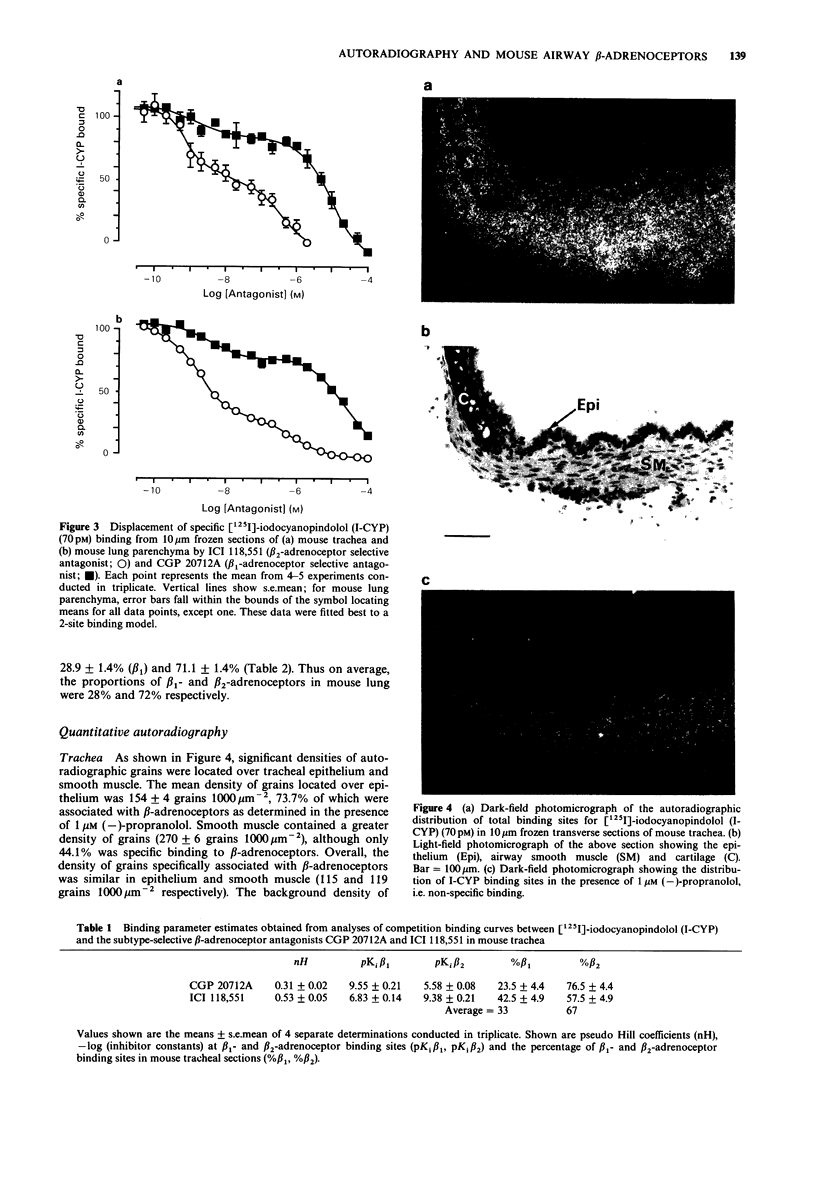
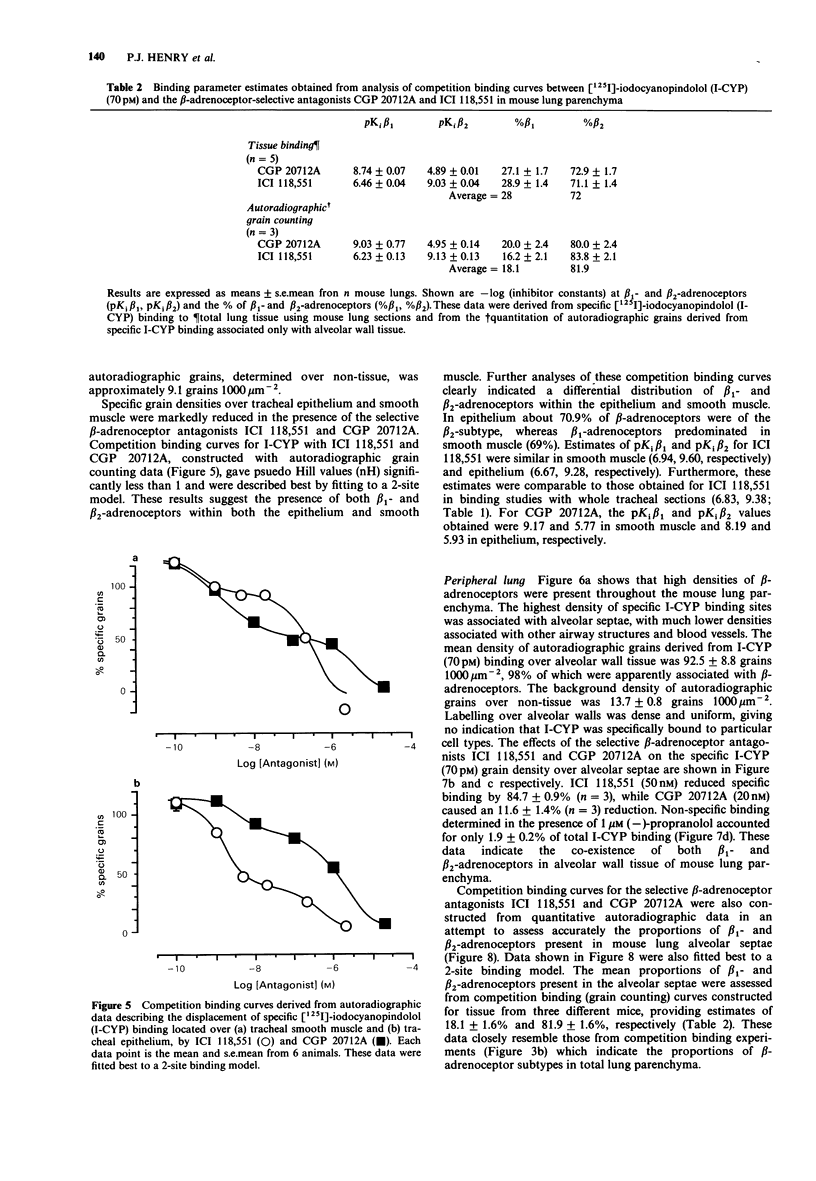
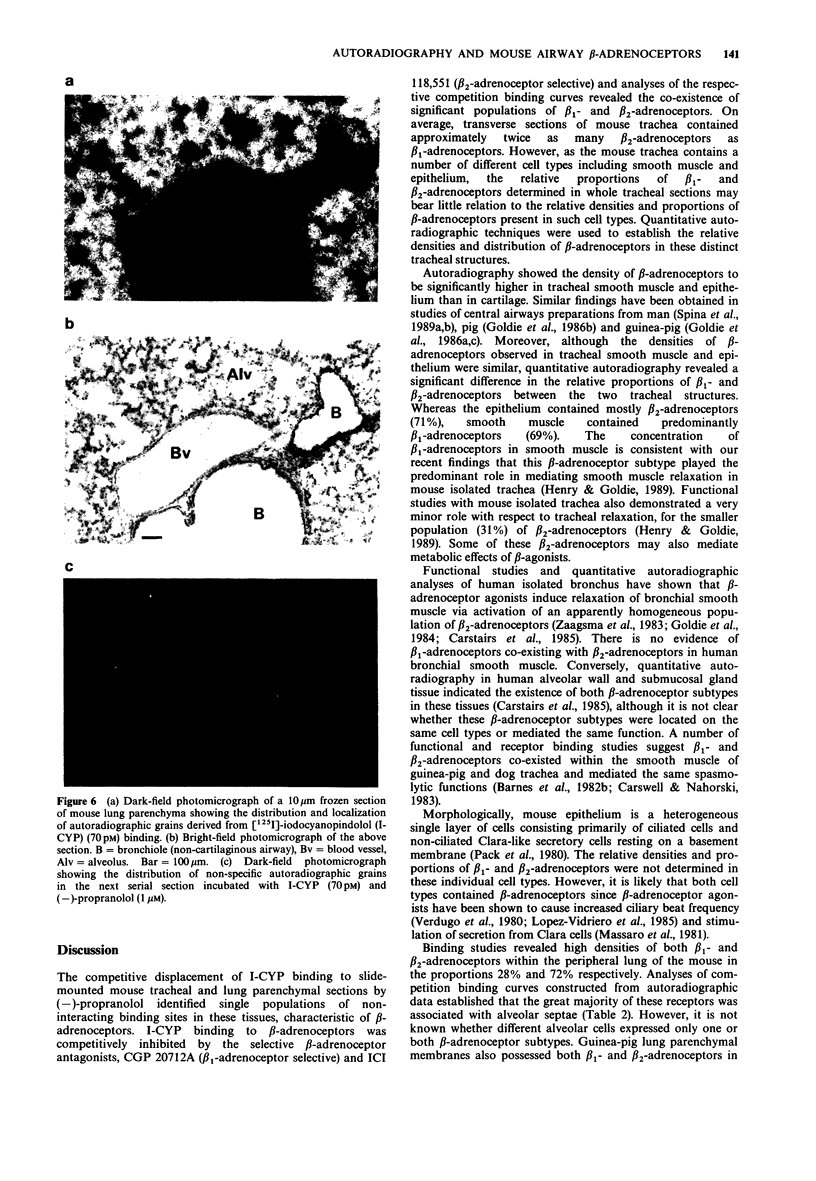
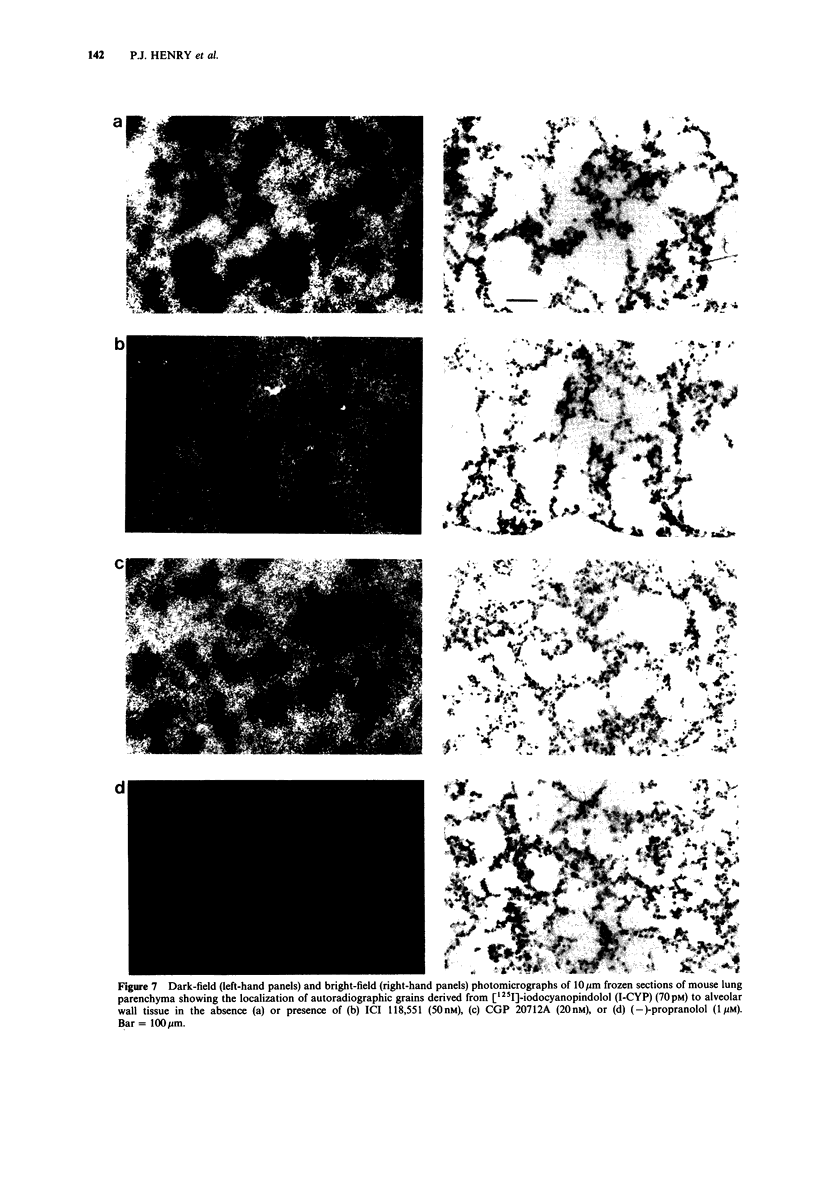
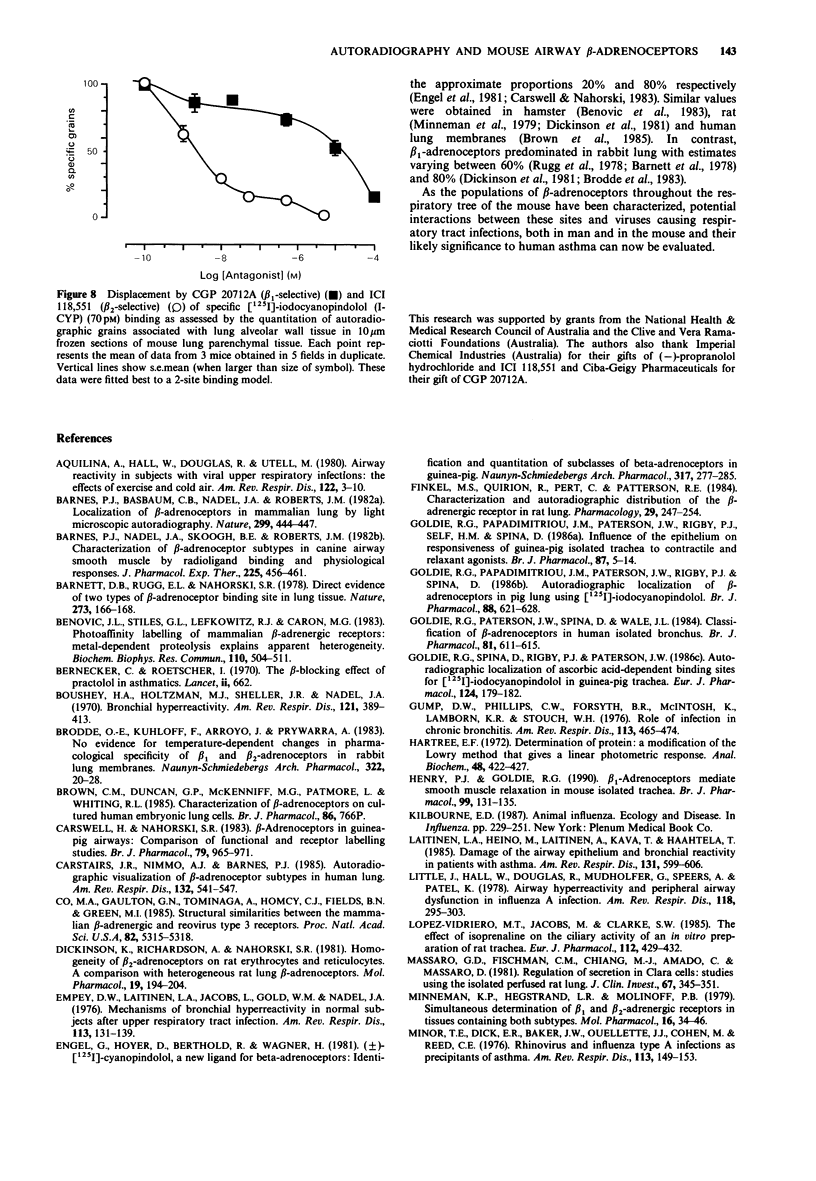
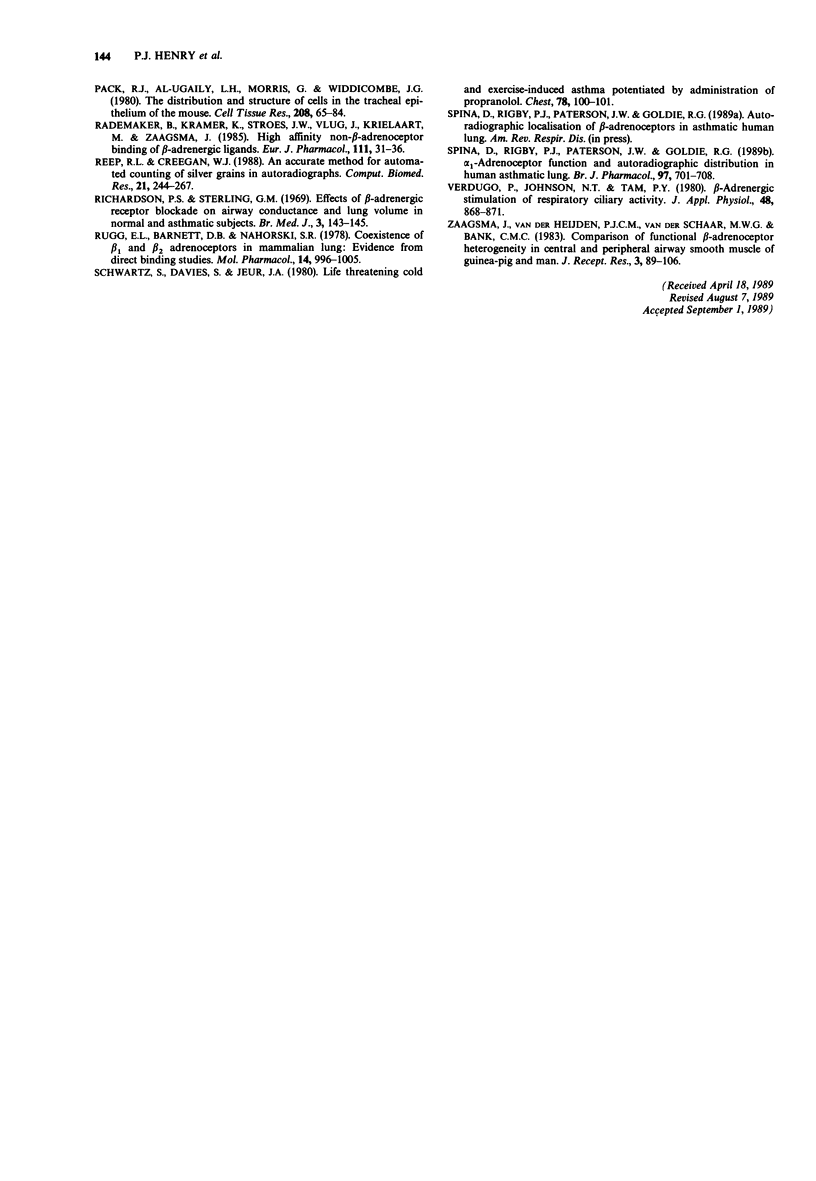
Images in this article
Selected References
These references are in PubMed. This may not be the complete list of references from this article.
- Aquilina A. T., Hall W. J., Douglas R. G., Jr, Utell M. J. Airway reactivity in subjects with viral upper respiratory tract infections: the effects of exercise and cold air. Am Rev Respir Dis. 1980 Jul;122(1):3–10. doi: 10.1164/arrd.1980.122.1.3. [DOI] [PubMed] [Google Scholar]
- Barnes P. J., Basbaum C. B., Nadel J. A., Roberts J. M. Localization of beta-adrenoreceptors in mammalian lung by light microscopic autoradiography. Nature. 1982 Sep 30;299(5882):444–447. doi: 10.1038/299444a0. [DOI] [PubMed] [Google Scholar]
- Barnes P. J., Nadel J. A., Skoogh B. E., Roberts J. M. Characterization of beta adrenoceptor subtypes in canine airway smooth muscle by radioligand binding and physiological responses. J Pharmacol Exp Ther. 1983 May;225(2):456–461. [PubMed] [Google Scholar]
- Barnett D. B., Rugg E. L., Nahorski S. R. Direct evidence of two types of beta adrenoceptor binding site in lung tissue. Nature. 1978 May 11;273(5658):166–168. doi: 10.1038/273166a0. [DOI] [PubMed] [Google Scholar]
- Benovic J. L., Stiles G. L., Lefkowitz R. J., Caron M. G. Photoaffinity labelling of mammalian beta-adrenergic receptors: metal-dependent proteolysis explains apparent heterogeneity. Biochem Biophys Res Commun. 1983 Jan 27;110(2):504–511. doi: 10.1016/0006-291x(83)91178-6. [DOI] [PubMed] [Google Scholar]
- Bernecker C., Roetscher I. The beta-blocking effect of practolol in asthmatics. Lancet. 1970 Sep 26;2(7674):662–662. doi: 10.1016/s0140-6736(70)91429-7. [DOI] [PubMed] [Google Scholar]
- Boushey H. A., Holtzman M. J., Sheller J. R., Nadel J. A. Bronchial hyperreactivity. Am Rev Respir Dis. 1980 Feb;121(2):389–413. doi: 10.1164/arrd.1980.121.2.389. [DOI] [PubMed] [Google Scholar]
- Brodde O. E., Kuhlhoff F., Arroyo J., Prywarra A. No evidence for temperature-dependent changes in the pharmacological specificity of beta 1- and beta 2-adrenoceptors in rabbit lung membranes. Naunyn Schmiedebergs Arch Pharmacol. 1983 Feb;322(1):20–28. doi: 10.1007/BF00649347. [DOI] [PubMed] [Google Scholar]
- Carstairs J. R., Nimmo A. J., Barnes P. J. Autoradiographic visualization of beta-adrenoceptor subtypes in human lung. Am Rev Respir Dis. 1985 Sep;132(3):541–547. doi: 10.1164/arrd.1985.132.3.541. [DOI] [PubMed] [Google Scholar]
- Carswell H., Nahorski S. R. Beta-adrenoceptor heterogeneity in guinea-pig airways: comparison of functional and receptor labelling studies. Br J Pharmacol. 1983 Aug;79(4):965–971. doi: 10.1111/j.1476-5381.1983.tb10542.x. [DOI] [PMC free article] [PubMed] [Google Scholar]
- Co M. S., Gaulton G. N., Tominaga A., Homcy C. J., Fields B. N., Greene M. I. Structural similarities between the mammalian beta-adrenergic and reovirus type 3 receptors. Proc Natl Acad Sci U S A. 1985 Aug;82(16):5315–5318. doi: 10.1073/pnas.82.16.5315. [DOI] [PMC free article] [PubMed] [Google Scholar]
- Dickinson K., Richardson A., Nahorski S. R. Homogeneity of beta 2-adrenoceptors on rat erythrocytes and reticulocytes. A comparison with heterogeneous rat lung beta-adrenoceptors. Mol Pharmacol. 1981 Mar;19(2):194–204. [PubMed] [Google Scholar]
- Empey D. W., Laitinen L. A., Jacobs L., Gold W. M., Nadel J. A. Mechanisms of bronchial hyperreactivity in normal subjects after upper respiratory tract infection. Am Rev Respir Dis. 1976 Feb;113(2):131–139. doi: 10.1164/arrd.1976.113.2.131. [DOI] [PubMed] [Google Scholar]
- Engel G., Hoyer D., Berthold R., Wagner H. (+/-)[125Iodo] cyanopindolol, a new ligand for beta-adrenoceptors: identification and quantitation of subclasses of beta-adrenoceptors in guinea pig. Naunyn Schmiedebergs Arch Pharmacol. 1981;317(4):277–285. doi: 10.1007/BF00501307. [DOI] [PubMed] [Google Scholar]
- Finkel M. S., Quirion R., Pert C., Patterson R. E. Characterization and autoradiographic distribution of the beta-adrenergic receptor in the rat lung. Pharmacology. 1984;29(5):247–254. doi: 10.1159/000138020. [DOI] [PubMed] [Google Scholar]
- Goldie R. G., Papadimitriou J. M., Paterson J. W., Rigby P. J., Self H. M., Spina D. Influence of the epithelium on responsiveness of guinea-pig isolated trachea to contractile and relaxant agonists. Br J Pharmacol. 1986 Jan;87(1):5–14. doi: 10.1111/j.1476-5381.1986.tb10150.x. [DOI] [PMC free article] [PubMed] [Google Scholar]
- Goldie R. G., Papadimitriou J. M., Paterson J. W., Rigby P. J., Spina D. Autoradiographic localization of beta-adrenoceptors in pig lung using [125I]-iodocyanopindolol. Br J Pharmacol. 1986 Jul;88(3):621–628. doi: 10.1111/j.1476-5381.1986.tb10243.x. [DOI] [PMC free article] [PubMed] [Google Scholar]
- Goldie R. G., Paterson J. W., Spina D., Wale J. L. Classification of beta-adrenoceptors in human isolated bronchus. Br J Pharmacol. 1984 Apr;81(4):611–615. doi: 10.1111/j.1476-5381.1984.tb16125.x. [DOI] [PMC free article] [PubMed] [Google Scholar]
- Goldie R. G., Spina D., Rigby P. J., Paterson J. W. Autoradiographic localisation of ascorbic acid-dependent binding sites for [125I]iodocyanopindolol in guinea-pig trachea. Eur J Pharmacol. 1986 May 13;124(1-2):179–182. doi: 10.1016/0014-2999(86)90141-x. [DOI] [PubMed] [Google Scholar]
- Gump D. W., Phillips C. A., Forsyth B. R., McIntosh K., Lamborn K. R., Stouch W. H. Role of infection in chronic bronchitis. Am Rev Respir Dis. 1976 Apr;113(4):465–474. doi: 10.1164/arrd.1976.113.4.465. [DOI] [PubMed] [Google Scholar]
- Hartree E. F. Determination of protein: a modification of the Lowry method that gives a linear photometric response. Anal Biochem. 1972 Aug;48(2):422–427. doi: 10.1016/0003-2697(72)90094-2. [DOI] [PubMed] [Google Scholar]
- Henry P. J., Goldie R. G. Beta 1-adrenoceptors mediate smooth muscle relaxation in mouse isolated trachea. Br J Pharmacol. 1990 Jan;99(1):131–135. doi: 10.1111/j.1476-5381.1990.tb14666.x. [DOI] [PMC free article] [PubMed] [Google Scholar]
- Laitinen L. A., Heino M., Laitinen A., Kava T., Haahtela T. Damage of the airway epithelium and bronchial reactivity in patients with asthma. Am Rev Respir Dis. 1985 Apr;131(4):599–606. doi: 10.1164/arrd.1985.131.4.599. [DOI] [PubMed] [Google Scholar]
- Little J. W., Hall W. J., Douglas R. G., Jr, Mudholkar G. S., Speers D. M., Patel K. Airway hyperreactivity and peripheral airway dysfunction in influenza A infection. Am Rev Respir Dis. 1978 Aug;118(2):295–303. doi: 10.1164/arrd.1978.118.2.295. [DOI] [PubMed] [Google Scholar]
- Lopez-Vidriero M. T., Jacobs M., Clarke S. W. The effect of isoprenaline on the ciliary activity of an in vitro preparation of rat trachea. Eur J Pharmacol. 1985 Jun 19;112(3):429–432. doi: 10.1016/0014-2999(85)90793-9. [DOI] [PubMed] [Google Scholar]
- Massaro G. D., Fischman C. M., Chiang M. J., Amado C., Massaro D. Regulation of secretion in Clara cells: studies using the isolated perfused rat lung. J Clin Invest. 1981 Feb;67(2):345–351. doi: 10.1172/JCI110041. [DOI] [PMC free article] [PubMed] [Google Scholar]
- Minneman K. P., Hegstrand L. R., Molinoff P. B. Simultaneous determination of beta-1 and beta-2-adrenergic receptors in tissues containing both receptor subtypes. Mol Pharmacol. 1979 Jul;16(1):34–46. [PubMed] [Google Scholar]
- Minor T. E., Dick E. C., Baker J. W., Ouellette J. J., Cohen M., Reed C. E. Rhinovirus and influenza type A infections as precipitants of asthma. Am Rev Respir Dis. 1976 Feb;113(2):149–153. doi: 10.1164/arrd.1976.113.2.149. [DOI] [PubMed] [Google Scholar]
- Pack R. J., Al-Ugaily L. H., Morris G., Widdicombe J. G. The distribution and structure of cells in the tracheal epithelium of the mouse. Cell Tissue Res. 1980;208(1):65–84. doi: 10.1007/BF00234174. [DOI] [PubMed] [Google Scholar]
- Rademaker B., Kramer K., Stroes J. W., Vlug J., Krielaart M., Zaagsma J. High affinity non-beta-adrenoceptor binding of beta-adrenergic ligands. Eur J Pharmacol. 1985 Apr 23;111(1):31–36. doi: 10.1016/0014-2999(85)90110-4. [DOI] [PubMed] [Google Scholar]
- Reep R. L., Creegan W. J. An accurate method for automated counting of silver grains in autoradiographs. Comput Biomed Res. 1988 Jun;21(3):244–267. doi: 10.1016/0010-4809(88)90031-6. [DOI] [PubMed] [Google Scholar]
- Richardson P. S., Sterling G. M. Effects of beta-adrenergic receptor blockade on airway conductance and lung volume in normal and asthmatic subjects. Br Med J. 1969 Jul 19;3(5663):143–145. doi: 10.1136/bmj.3.5663.143. [DOI] [PMC free article] [PubMed] [Google Scholar]
- Rugg E. L., Barnett D. B., Nahorski S. R. Coexistence of beta1 and beta2 adrenoceptors in mammalian lung: evidence from direct binding studies. Mol Pharmacol. 1978 Nov;14(6):996–1005. [PubMed] [Google Scholar]
- Schwartz S., Davies S., Juers J. A. Life-threatening cold and exercise-induced asthma potentiated by administration of propranolol. Chest. 1980 Jul;78(1):100–101. doi: 10.1378/chest.78.1.100. [DOI] [PubMed] [Google Scholar]
- Spina D., Rigby P. J., Paterson J. W., Goldie R. G. Alpha 1-adrenoceptor function and autoradiographic distribution in human asthmatic lung. Br J Pharmacol. 1989 Jul;97(3):701–708. doi: 10.1111/j.1476-5381.1989.tb12006.x. [DOI] [PMC free article] [PubMed] [Google Scholar]
- Verdugo P., Johnson N. T., Tam P. Y. beta-Adrenergic stimulation of respiratory ciliary activity. J Appl Physiol Respir Environ Exerc Physiol. 1980 May;48(5):868–871. doi: 10.1152/jappl.1980.48.5.868. [DOI] [PubMed] [Google Scholar]
- Zaagsma J., van der Heijden P. J., van der Schaar M. W., Bank C. M. Comparison of functional beta-adrenoceptor heterogeneity in central and peripheral airway smooth muscle of guinea pig and man. J Recept Res. 1983;3(1-2):89–106. doi: 10.3109/10799898309041925. [DOI] [PubMed] [Google Scholar]




